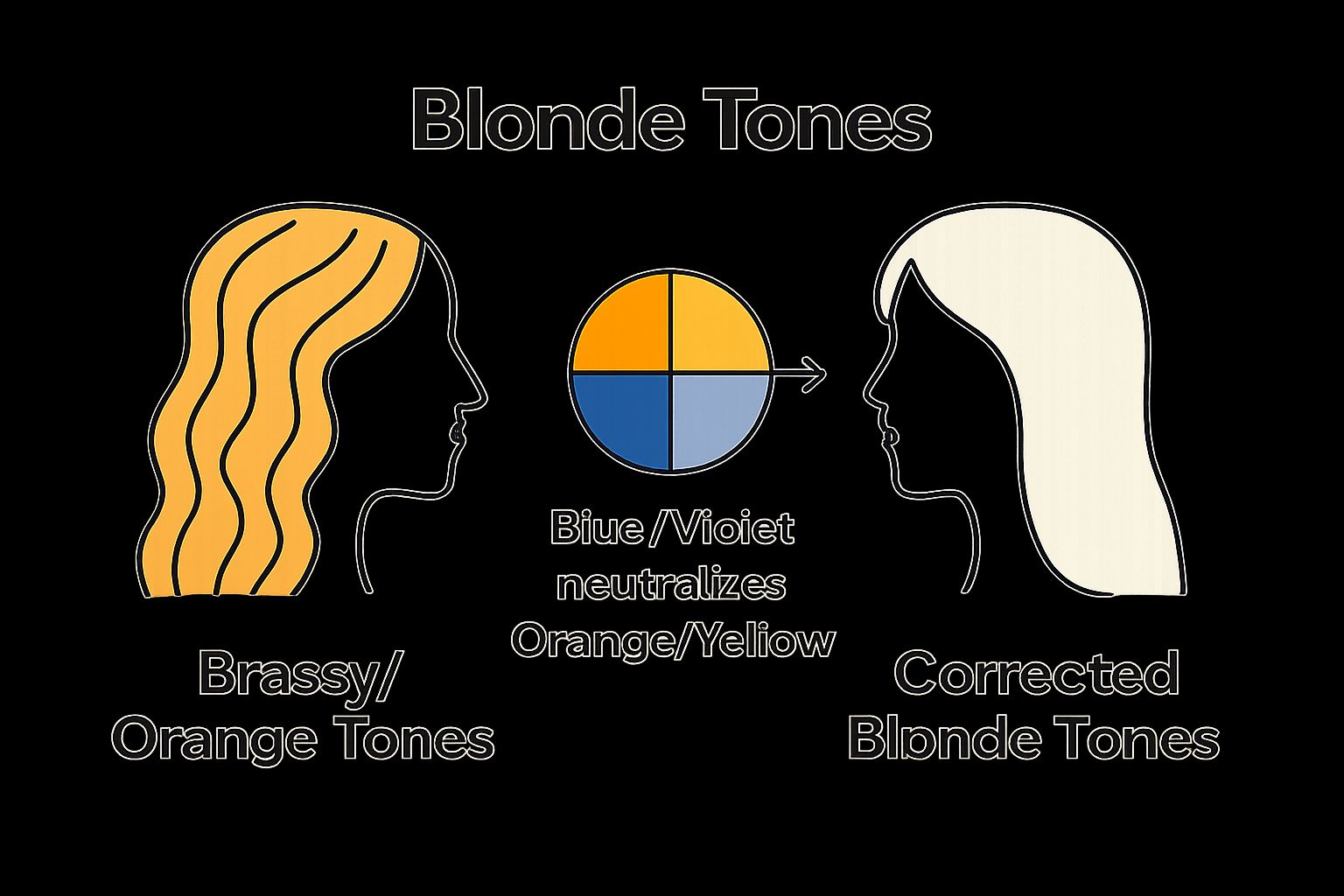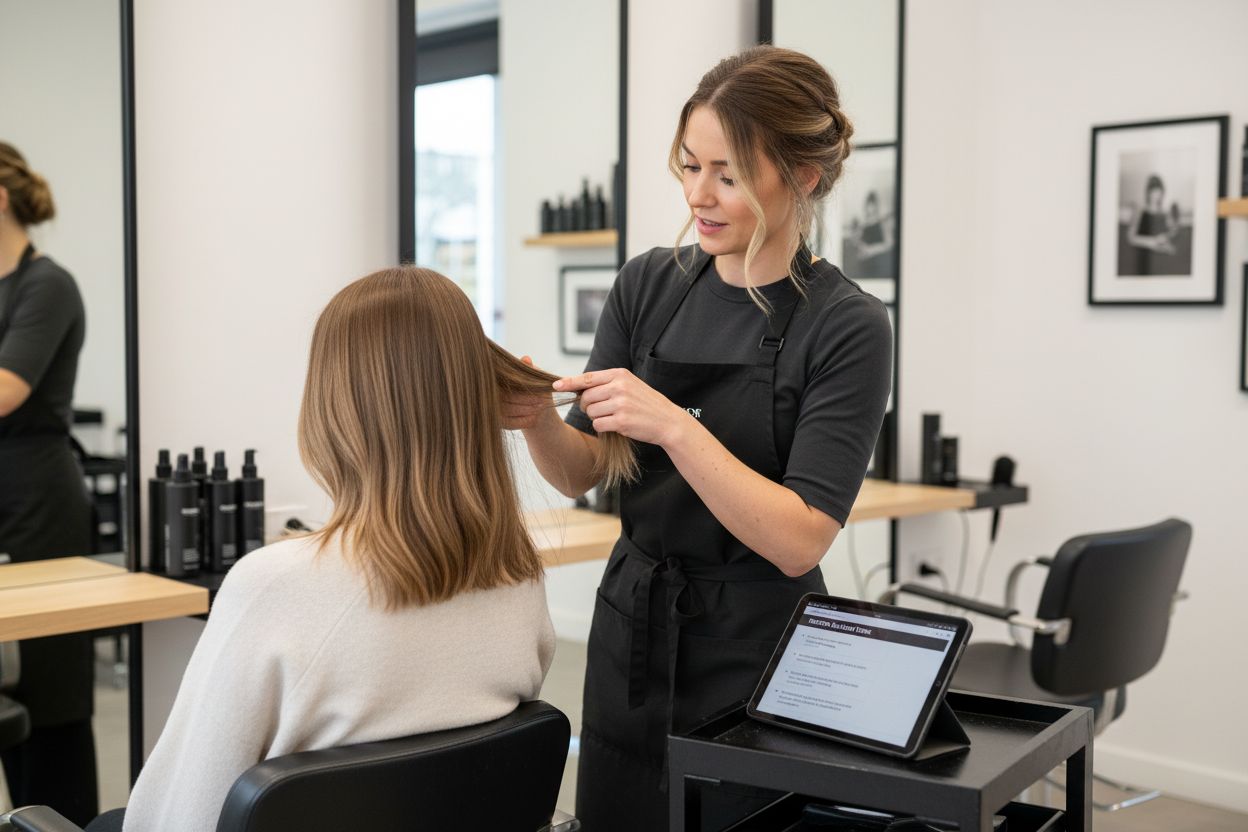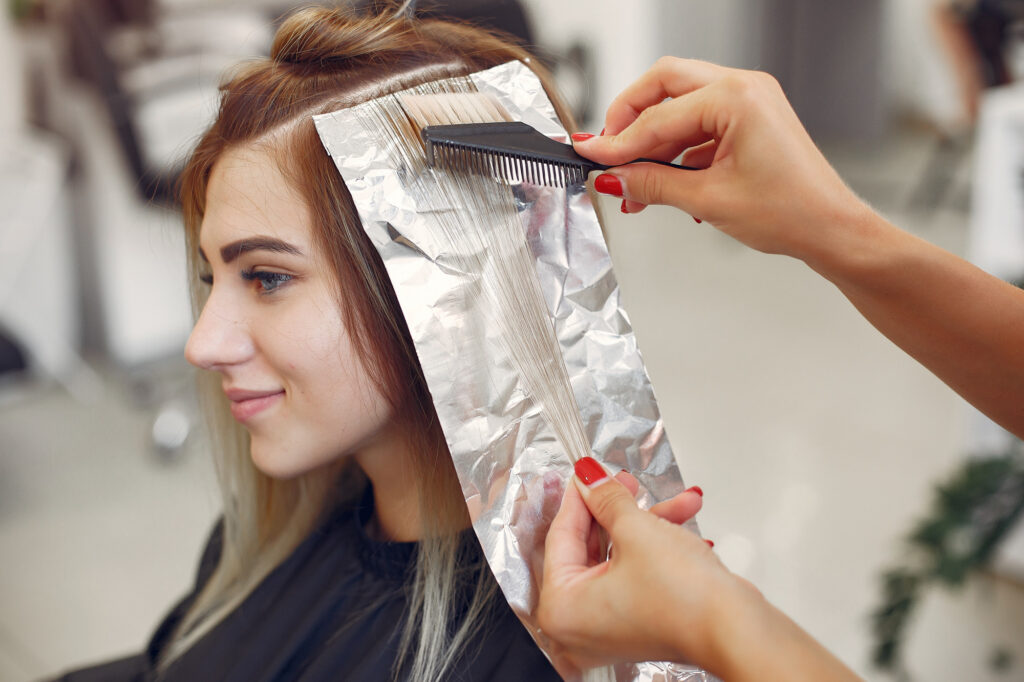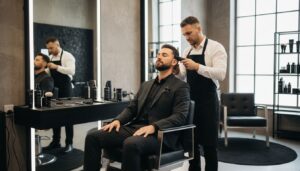Color correction can rescue hair disasters and bring back your favorite shades. Think your last dye job ruined your look? Around 20 percent of people who color their hair at home end up needing professional color correction. Most believe this process is just about covering mistakes, but the truth is that color correction is more about science and precision than patching over errors.
Table of Contents
- What Is Color Correction And Why Is It Important?
- The Science Of Color In Hair: How It Works
- Common Reasons For Color Correction: Understanding The Need
- Key Concepts In Color Theory: Hue, Saturation, And Brightness
- Real-World Applications Of Color Correction In Luxury Hair Services
Quick Summary
| Takeaway | Explanation |
|---|---|
| Color correction restores hair to desired shades | It addresses undesired hair color results using expert techniques to achieve preferred tones and appearances. |
| Professional intervention prevents hair damage | Experts minimize color-related damage by preserving hair integrity and managing chemical processes effectively. |
| Understanding color theory enhances correction effectiveness | Knowledge of hue, saturation, and brightness aids stylists in neutralizing unwanted tones for precise results. |
| Complex corrections require tailored approaches | Each color correction scenario is unique, demanding customized strategies based on individual hair characteristics and history. |
| Client-focused consultations ensure better outcomes | Comprehensive assessments and personalized plans from professionals lead to successful and satisfying color transformations. |
What is Color Correction and Why is it Important?
Color correction is a specialized hair treatment technique designed to address and rectify undesirable hair color results. When your hair color doesn’t turn out as expected, professional stylists use strategic methods to restore your hair to the desired shade, tone, and overall appearance.
Understanding Color Correction Basics
Color correction goes beyond simple hair dyeing. It involves carefully analyzing your current hair color, identifying problematic tones, and implementing precise techniques to neutralize or transform unwanted colors.
Professional color specialists use advanced color theory principles to diagnose and resolve complex color issues.
The process typically addresses several common hair color challenges:

- Brassy or orange tones in blonde hair
- Uneven color distribution
- Dark patches or roots that don’t match the rest of the hair
- Color that appears too warm or too cool
Why Color Correction Matters
Color correction is crucial for maintaining the health and aesthetic appeal of your hair. Improper color application can lead to significant damage, making professional intervention essential. Incorrect color treatments can strip hair of its natural moisture, weaken hair structure, and create long-lasting visual inconsistencies.
Professional color correction helps prevent additional damage by:
- Minimizing repeated chemical processing
- Protecting hair’s natural integrity
- Restoring a harmonious, natural-looking color
- Preventing further color complications
Successful color correction requires expert knowledge of color chemistry, hair texture, and individual hair characteristics. Each correction is a unique process tailored to the specific needs of the client’s hair, making it far more complex than a standard color application.

The Science of Color in Hair: How It Works
Understanding hair color requires diving into the complex biochemical structure of hair and how color molecules interact with its intricate layers. Hair color is not simply about applying pigment but involves a sophisticated chemical process that transforms the hair’s natural appearance.
Natural Hair Pigment Foundations
Scientific research reveals that hair color originates from two primary pigments: eumelanin and pheomelanin. Eumelanin produces brown and black shades, while pheomelanin generates red and yellow tones. The concentration and ratio of these pigments determine an individual’s natural hair color.
Key characteristics of hair pigmentation include:
- Genetic inheritance determines baseline pigment production
- Pigment concentration varies across different hair sections
- Aging reduces pigment production, leading to gray hair
- Environmental factors can subtly influence pigment intensity
Chemical Transformation of Hair Color
Hair color treatments work by penetrating the hair’s protective cuticle layer and interacting with its internal structure. Professional colorists use oxidative agents like hydrogen peroxide to break down existing pigments and create space for new color molecules to bond.
The color transformation process involves several critical steps:
- Opening the hair cuticle using alkaline solutions
- Removing existing pigments through controlled chemical reactions
- Depositing new color molecules into the hair shaft
- Sealing the cuticle to lock in the new color
Precision is paramount in this process, as incorrect chemical interactions can lead to unintended color results or potential hair damage. Professional colorists understand the delicate balance required to achieve desired hair color while maintaining hair health.
Common Reasons for Color Correction: Understanding the Need
Color correction is a nuanced process addressing multiple hair color challenges that emerge from various technical and personal styling decisions. Understanding these common scenarios helps individuals recognize when professional intervention becomes necessary.
Here is a comparison table highlighting the primary differences between DIY color mistakes and professional color transformation challenges, summarizing the common color correction scenarios discussed in this section for easy reference.
| Scenario | Typical Causes | Common Results | Correction Approach |
|---|---|---|---|
| DIY Color Gone Wrong | Inexperienced application, wrong product selection, miscalculating processing time | Uneven color, brassy tones, unexpected shades | Expert analysis, neutralization, rebalance |
| Professional Transformation Issues | Dramatic shade changes, previous permanent color, undertone conflicts | Unwanted undertones, visible banding, color imbalance | Multi-step corrections, pigment removal, tone balancing |
DIY Color Gone Wrong
Hair color professionals frequently encounter situations where home hair coloring attempts produce unexpected and undesirable results. Inexperienced application can lead to significant color discrepancies that require expert correction.
Typical DIY color mishaps include:
- Uneven color application across hair sections
- Selecting a hair color that conflicts with natural undertones
- Miscalculating processing time
- Using inappropriate developer strength
- Failing to account for existing hair color or previous treatments
Professional Color Transformation Challenges
Professional color corrections are not always about correcting mistakes. Sometimes they represent intentional, sophisticated color transitions that require multiple technical steps. These transformations might involve dramatic shade changes like transitioning from dark to light hair or neutralizing unwanted undertones.
Complex color correction scenarios often involve:
- Converting extremely dark hair to platinum blonde
- Removing previous permanent hair color
- Balancing brassy or orange tones
- Blending gray hair with natural or artificial pigments
Protecting Hair Health During Correction
Color correction is more than aesthetic improvement. It represents a critical intervention to maintain hair’s structural integrity and visual appeal. Professional stylists assess potential damage, strategize color restoration, and implement techniques that minimize stress on hair fibers.
Key considerations during color correction include:
- Evaluating hair’s current condition and resilience
- Selecting appropriate color neutralization techniques
- Implementing treatments to restore hair moisture
- Developing a phased approach for complex color transformations
Successful color correction requires a combination of technical expertise, artistic vision, and a deep understanding of hair chemistry.
Key Concepts in Color Theory: Hue, Saturation, and Brightness
Color theory represents a sophisticated framework that helps professionals understand and manipulate color interactions, particularly in hair color correction. By comprehending the fundamental elements of color, stylists can create precise and nuanced transformations that go beyond simple pigmentation.
Understanding Fundamental Color Elements
Color experts define three primary attributes that describe color complexity: hue, saturation, and brightness. Hue represents the pure color itself – like red, blue, or green – while saturation indicates the color’s intensity, and brightness determines how light or dark the color appears.
Key characteristics of color elements include:
- Hue defines the base color perception
- Saturation controls color vibrancy
- Brightness influences the color’s tonal range
- Each element interacts dynamically with others
This table defines the three essential elements of color theory (hue, saturation, and brightness), providing clear explanations and their relevance to hair color correction for quick reference.
| Element | Definition | Importance in Hair Color Correction |
|---|---|---|
| Hue | The base color, such as red, blue, or green | Determines the foundation of hair color |
| Saturation | The intensity or purity of the color | Controls how vibrant or muted the color appears |
| Brightness | How light or dark the color is | Affects the overall depth and tone of the result |
Practical Applications in Hair Color Correction
Professional colorists leverage color theory principles to neutralize unwanted tones and achieve desired hair color results. Understanding how different color elements interact allows for strategic color manipulation.
Color correction strategies involve:
- Identifying underlying pigment undertones
- Selecting complementary colors to neutralize unwanted shades
- Adjusting color intensity through precise saturation control
- Balancing overall color appearance by modifying brightness
Advanced Color Interaction Principles
Color theory goes beyond simple visual perception. It involves complex chemical and visual interactions that require deep technical knowledge. Professional colorists must understand how different pigments interact, cancel, or enhance each other to create precise color transformations.
Advanced color correction principles recognize that:
- Complementary colors neutralize each other
- Subtle color variations require nuanced approaches
Successful color correction demands a combination of scientific understanding and artistic intuition.
Real-World Applications of Color Correction in Luxury Hair Services
Luxury hair services elevate color correction from a technical procedure to an art form, transforming challenging color scenarios into stunning, personalized hair transformations. Professional stylists approach each client’s unique hair profile with precision, creativity, and advanced technical expertise.
High-End Transformation Techniques
Professional hair colorists employ sophisticated strategies that go beyond standard color application. Luxury color correction involves comprehensive hair analysis, examining not just current color but also hair health, texture, and individual styling goals.
Advanced transformation techniques include:
- Multilayered color blending
- Precision tone neutralization
- Custom pigment mapping
- Strategic highlighting and lowlighting
- Personalized color transition planning
Specialized Correction Scenarios
Complex color correction demands a holistic approach. Luxury hair services address intricate color challenges that require more than standard treatment. These scenarios might involve dramatic color shifts, correcting previous unsuccessful color treatments, or creating seamless, natural-looking color transitions.
Specialized correction scenarios often involve:
- Converting chemically damaged hair to desired shade
- Neutralizing extreme color discrepancies
- Blending multiple hair color histories
- Restoring hair’s natural vitality during transformation
Client-Centric Color Restoration
Luxury hair services recognize that color correction is a collaborative process. Explore our expert color correction services that prioritize individual client needs, combining technical mastery with personalized artistic vision.
Client-focused approaches emphasize:
- Comprehensive initial consultation
- Detailed hair health assessment
- Customized color strategy development
- Ongoing maintenance recommendations
Successful color correction transcends technical skill, representing a transformative experience that harmonizes scientific precision with creative expression.
Transform Your Hair With Expert Color Correction at Joel C Ma Hair Studio
If you have ever been disappointed by unexpected hair color results or struggled with uneven tones and damage after a DIY attempt, you understand how challenging true color correction can be. Your hair deserves more than a quick fix. It requires precise analysis and the artistry to restore its beauty, as described in our guide on color correction basics. Joel C Ma Hair Studio in La Jolla takes this science and turns it into luxury, offering personalized color solutions that protect your hair’s health and deliver the flawless, vibrant look you desire. Our expert team uses advanced color theory, customized consultations, and innovative repair techniques, ensuring every step supports both the appearance and integrity of your hair.

Ready to leave uneven color and brassy tones behind? Experience the confidence that comes from trusting award-winning professionals. Visit our Luxury Hair Color Corrections page to explore how we solve even the most complex color challenges. Or book a consultation directly on Joel C Ma Hair Studio and let your transformation begin today. Your perfect hair color is only one expert appointment away.
Frequently Asked Questions
What is color correction for hair?
Color correction is a specialized hair treatment that fixes undesirable hair color results. To begin your color correction journey, consult with a professional stylist who can analyze your hair and determine the appropriate correction methods.
Why is color correction important for maintaining hair health?
Color correction is crucial as it helps restore hair’s natural appearance and integrity. Schedule a thorough evaluation with a color specialist to minimize damage from previous treatments and achieve the desired color safely.
How can I identify if my hair needs color correction?
You may need color correction if you notice brassy tones, uneven color distribution, or dark patches that don’t match the rest of your hair. Keep track of your hair’s appearance after coloring and seek a professional assessment if the color isn’t what you expected within a few weeks.
What are the common methods used in color correction?
Color correction methods can include neutralizing brassy tones, rebalancing uneven color, or adjusting the underlying pigments. Consider starting with a consultation to understand the best approach for your specific hair color challenges.
How long does a typical color correction treatment take?
A color correction treatment can take several hours, depending on the complexity of the corrections needed. Prepare for potential multiple sessions, especially if transitioning between drastically different color shades to protect your hair from damage.
Can I perform color correction at home?
While minor corrections can be attempted at home, it’s generally recommended to seek professional help for best results. If you’re considering doing it yourself, start by researching the right products for your hair type and color needs before making any changes.





